Performance Trend of Australian Economy: Analysis of GDP Growth, Inflation, Unemployment, Net Export, and Exchange Rate
VerifiedAdded on 2023/06/11
|14
|4385
|276
AI Summary
The report summarizes performance trend of Australian economy for a period extending from 1990 to 2016. In addition to narrates the trend in basic performance indicator, the paper explores the relation between economic growth, inflation and unemployment. A relation also has also attempted to framed between exchange rate and net export. Policy interconnectedness has been observed from trend movement in cash rate and fund rate.
Contribute Materials
Your contribution can guide someone’s learning journey. Share your
documents today.
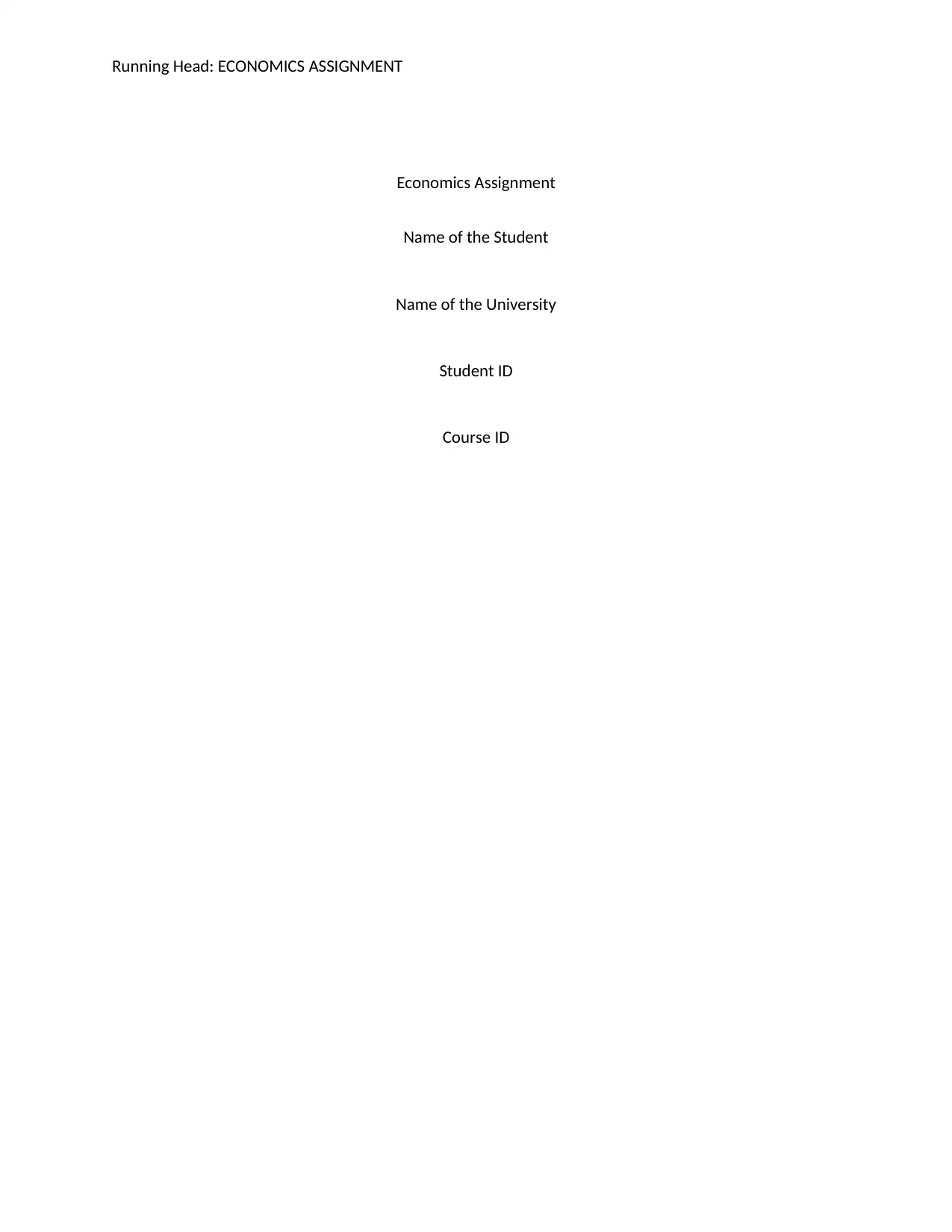
Running Head: ECONOMICS ASSIGNMENT
Economics Assignment
Name of the Student
Name of the University
Student ID
Course ID
Economics Assignment
Name of the Student
Name of the University
Student ID
Course ID
Secure Best Marks with AI Grader
Need help grading? Try our AI Grader for instant feedback on your assignments.
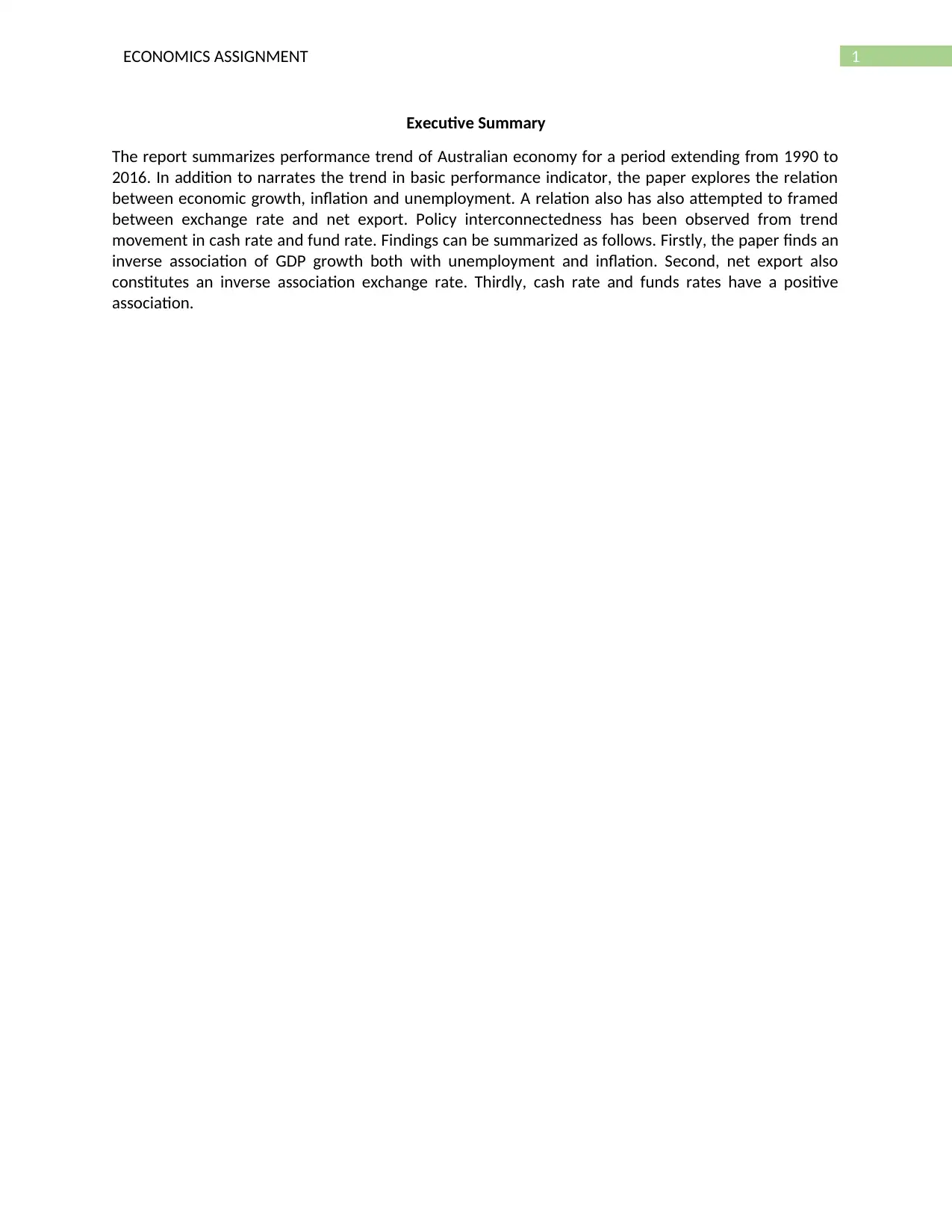
1ECONOMICS ASSIGNMENT
Executive Summary
The report summarizes performance trend of Australian economy for a period extending from 1990 to
2016. In addition to narrates the trend in basic performance indicator, the paper explores the relation
between economic growth, inflation and unemployment. A relation also has also attempted to framed
between exchange rate and net export. Policy interconnectedness has been observed from trend
movement in cash rate and fund rate. Findings can be summarized as follows. Firstly, the paper finds an
inverse association of GDP growth both with unemployment and inflation. Second, net export also
constitutes an inverse association exchange rate. Thirdly, cash rate and funds rates have a positive
association.
Executive Summary
The report summarizes performance trend of Australian economy for a period extending from 1990 to
2016. In addition to narrates the trend in basic performance indicator, the paper explores the relation
between economic growth, inflation and unemployment. A relation also has also attempted to framed
between exchange rate and net export. Policy interconnectedness has been observed from trend
movement in cash rate and fund rate. Findings can be summarized as follows. Firstly, the paper finds an
inverse association of GDP growth both with unemployment and inflation. Second, net export also
constitutes an inverse association exchange rate. Thirdly, cash rate and funds rates have a positive
association.

2ECONOMICS ASSIGNMENT
Table of Contents
Introduction.................................................................................................................................................3
Growth performance of Australia along with inflation and unemployment................................................3
Business Cycle in Australia...........................................................................................................................6
Association between net export and exchange rate...................................................................................7
Fund rate and cash rate...............................................................................................................................9
Forecasting economic outlook...................................................................................................................10
Conclusion.................................................................................................................................................11
Reference list.............................................................................................................................................12
Data source............................................................................................................................................12
Table of Contents
Introduction.................................................................................................................................................3
Growth performance of Australia along with inflation and unemployment................................................3
Business Cycle in Australia...........................................................................................................................6
Association between net export and exchange rate...................................................................................7
Fund rate and cash rate...............................................................................................................................9
Forecasting economic outlook...................................................................................................................10
Conclusion.................................................................................................................................................11
Reference list.............................................................................................................................................12
Data source............................................................................................................................................12
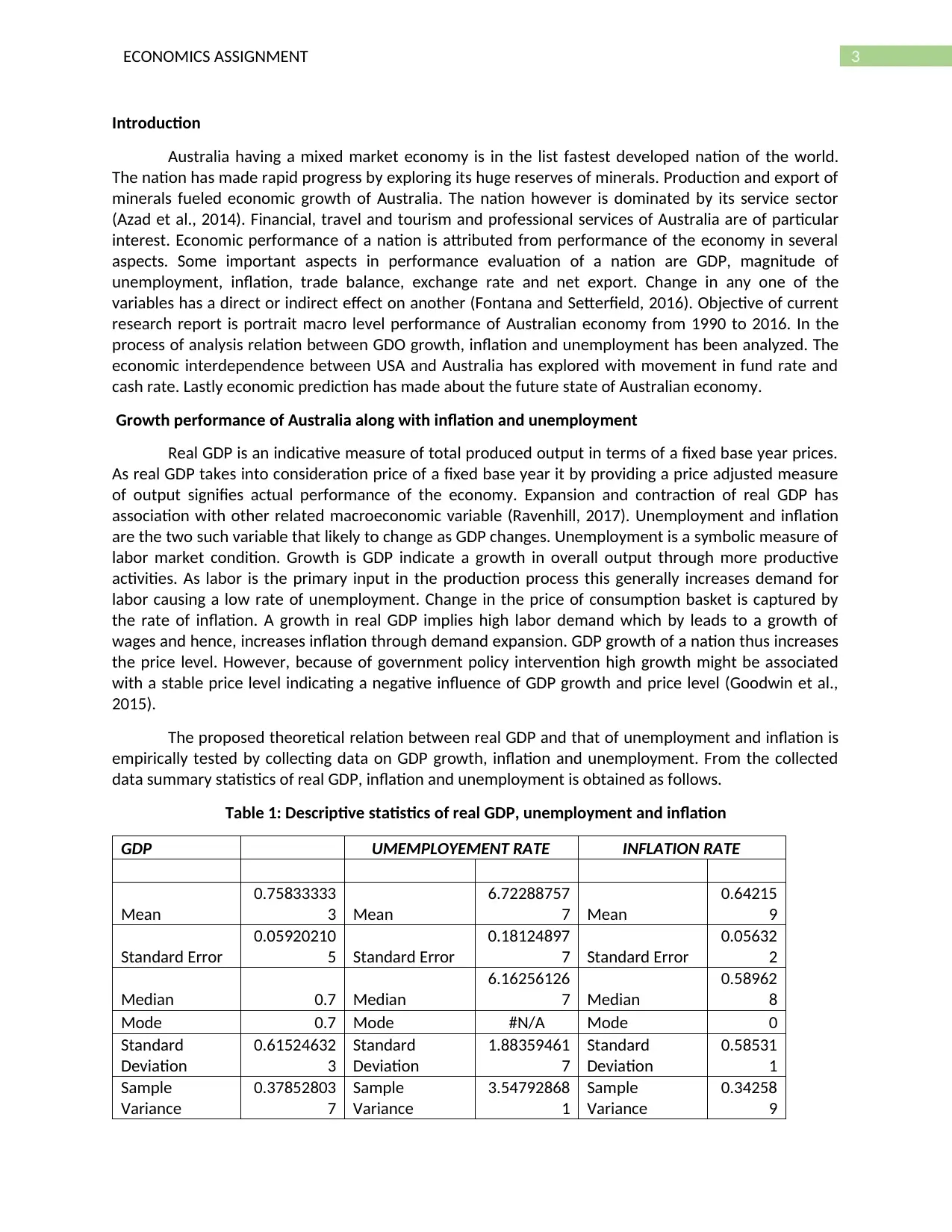
3ECONOMICS ASSIGNMENT
Introduction
Australia having a mixed market economy is in the list fastest developed nation of the world.
The nation has made rapid progress by exploring its huge reserves of minerals. Production and export of
minerals fueled economic growth of Australia. The nation however is dominated by its service sector
(Azad et al., 2014). Financial, travel and tourism and professional services of Australia are of particular
interest. Economic performance of a nation is attributed from performance of the economy in several
aspects. Some important aspects in performance evaluation of a nation are GDP, magnitude of
unemployment, inflation, trade balance, exchange rate and net export. Change in any one of the
variables has a direct or indirect effect on another (Fontana and Setterfield, 2016). Objective of current
research report is portrait macro level performance of Australian economy from 1990 to 2016. In the
process of analysis relation between GDO growth, inflation and unemployment has been analyzed. The
economic interdependence between USA and Australia has explored with movement in fund rate and
cash rate. Lastly economic prediction has made about the future state of Australian economy.
Growth performance of Australia along with inflation and unemployment
Real GDP is an indicative measure of total produced output in terms of a fixed base year prices.
As real GDP takes into consideration price of a fixed base year it by providing a price adjusted measure
of output signifies actual performance of the economy. Expansion and contraction of real GDP has
association with other related macroeconomic variable (Ravenhill, 2017). Unemployment and inflation
are the two such variable that likely to change as GDP changes. Unemployment is a symbolic measure of
labor market condition. Growth is GDP indicate a growth in overall output through more productive
activities. As labor is the primary input in the production process this generally increases demand for
labor causing a low rate of unemployment. Change in the price of consumption basket is captured by
the rate of inflation. A growth in real GDP implies high labor demand which by leads to a growth of
wages and hence, increases inflation through demand expansion. GDP growth of a nation thus increases
the price level. However, because of government policy intervention high growth might be associated
with a stable price level indicating a negative influence of GDP growth and price level (Goodwin et al.,
2015).
The proposed theoretical relation between real GDP and that of unemployment and inflation is
empirically tested by collecting data on GDP growth, inflation and unemployment. From the collected
data summary statistics of real GDP, inflation and unemployment is obtained as follows.
Table 1: Descriptive statistics of real GDP, unemployment and inflation
GDP UMEMPLOYEMENT RATE INFLATION RATE
Mean
0.75833333
3 Mean
6.72288757
7 Mean
0.64215
9
Standard Error
0.05920210
5 Standard Error
0.18124897
7 Standard Error
0.05632
2
Median 0.7 Median
6.16256126
7 Median
0.58962
8
Mode 0.7 Mode #N/A Mode 0
Standard
Deviation
0.61524632
3
Standard
Deviation
1.88359461
7
Standard
Deviation
0.58531
1
Sample
Variance
0.37852803
7
Sample
Variance
3.54792868
1
Sample
Variance
0.34258
9
Introduction
Australia having a mixed market economy is in the list fastest developed nation of the world.
The nation has made rapid progress by exploring its huge reserves of minerals. Production and export of
minerals fueled economic growth of Australia. The nation however is dominated by its service sector
(Azad et al., 2014). Financial, travel and tourism and professional services of Australia are of particular
interest. Economic performance of a nation is attributed from performance of the economy in several
aspects. Some important aspects in performance evaluation of a nation are GDP, magnitude of
unemployment, inflation, trade balance, exchange rate and net export. Change in any one of the
variables has a direct or indirect effect on another (Fontana and Setterfield, 2016). Objective of current
research report is portrait macro level performance of Australian economy from 1990 to 2016. In the
process of analysis relation between GDO growth, inflation and unemployment has been analyzed. The
economic interdependence between USA and Australia has explored with movement in fund rate and
cash rate. Lastly economic prediction has made about the future state of Australian economy.
Growth performance of Australia along with inflation and unemployment
Real GDP is an indicative measure of total produced output in terms of a fixed base year prices.
As real GDP takes into consideration price of a fixed base year it by providing a price adjusted measure
of output signifies actual performance of the economy. Expansion and contraction of real GDP has
association with other related macroeconomic variable (Ravenhill, 2017). Unemployment and inflation
are the two such variable that likely to change as GDP changes. Unemployment is a symbolic measure of
labor market condition. Growth is GDP indicate a growth in overall output through more productive
activities. As labor is the primary input in the production process this generally increases demand for
labor causing a low rate of unemployment. Change in the price of consumption basket is captured by
the rate of inflation. A growth in real GDP implies high labor demand which by leads to a growth of
wages and hence, increases inflation through demand expansion. GDP growth of a nation thus increases
the price level. However, because of government policy intervention high growth might be associated
with a stable price level indicating a negative influence of GDP growth and price level (Goodwin et al.,
2015).
The proposed theoretical relation between real GDP and that of unemployment and inflation is
empirically tested by collecting data on GDP growth, inflation and unemployment. From the collected
data summary statistics of real GDP, inflation and unemployment is obtained as follows.
Table 1: Descriptive statistics of real GDP, unemployment and inflation
GDP UMEMPLOYEMENT RATE INFLATION RATE
Mean
0.75833333
3 Mean
6.72288757
7 Mean
0.64215
9
Standard Error
0.05920210
5 Standard Error
0.18124897
7 Standard Error
0.05632
2
Median 0.7 Median
6.16256126
7 Median
0.58962
8
Mode 0.7 Mode #N/A Mode 0
Standard
Deviation
0.61524632
3
Standard
Deviation
1.88359461
7
Standard
Deviation
0.58531
1
Sample
Variance
0.37852803
7
Sample
Variance
3.54792868
1
Sample
Variance
0.34258
9
Secure Best Marks with AI Grader
Need help grading? Try our AI Grader for instant feedback on your assignments.
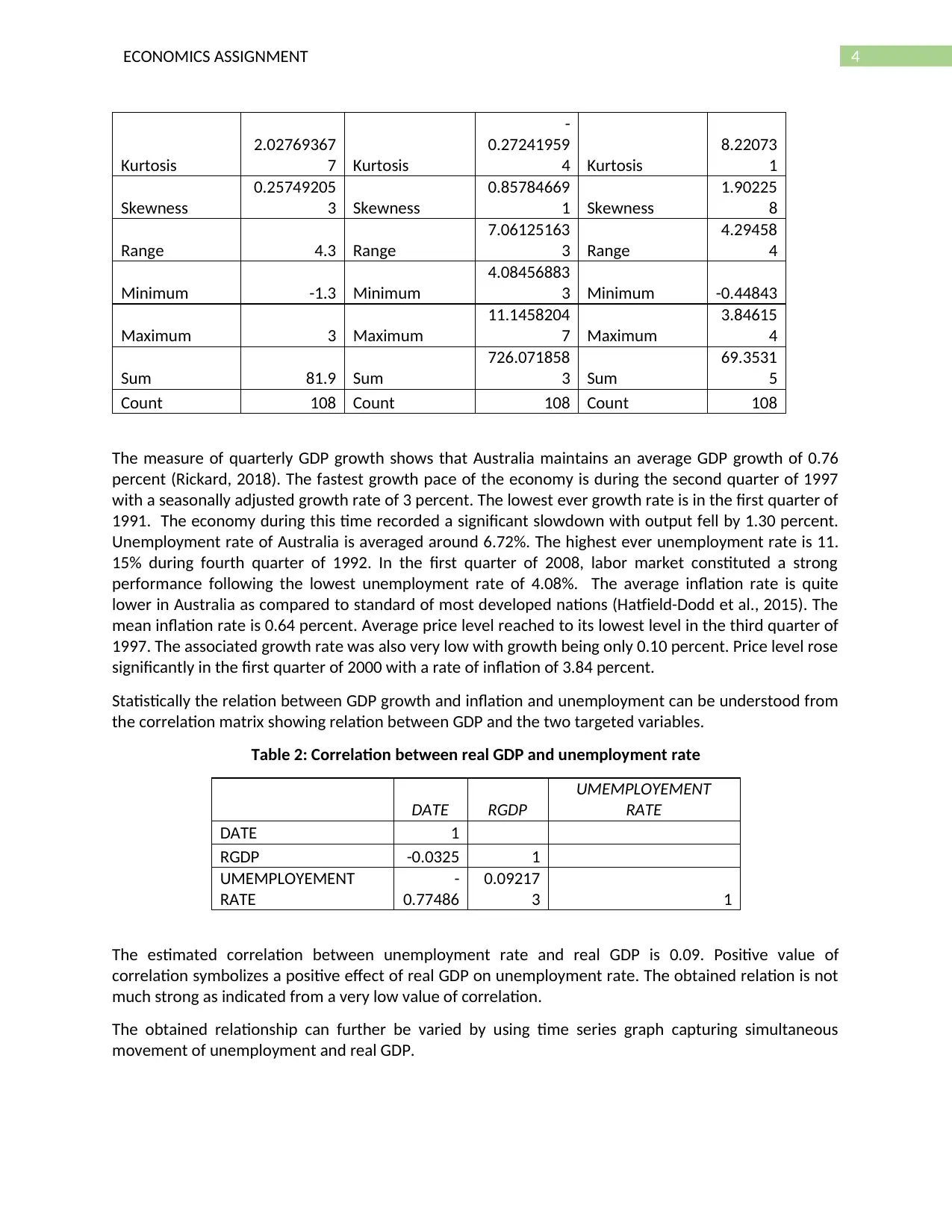
4ECONOMICS ASSIGNMENT
Kurtosis
2.02769367
7 Kurtosis
-
0.27241959
4 Kurtosis
8.22073
1
Skewness
0.25749205
3 Skewness
0.85784669
1 Skewness
1.90225
8
Range 4.3 Range
7.06125163
3 Range
4.29458
4
Minimum -1.3 Minimum
4.08456883
3 Minimum -0.44843
Maximum 3 Maximum
11.1458204
7 Maximum
3.84615
4
Sum 81.9 Sum
726.071858
3 Sum
69.3531
5
Count 108 Count 108 Count 108
The measure of quarterly GDP growth shows that Australia maintains an average GDP growth of 0.76
percent (Rickard, 2018). The fastest growth pace of the economy is during the second quarter of 1997
with a seasonally adjusted growth rate of 3 percent. The lowest ever growth rate is in the first quarter of
1991. The economy during this time recorded a significant slowdown with output fell by 1.30 percent.
Unemployment rate of Australia is averaged around 6.72%. The highest ever unemployment rate is 11.
15% during fourth quarter of 1992. In the first quarter of 2008, labor market constituted a strong
performance following the lowest unemployment rate of 4.08%. The average inflation rate is quite
lower in Australia as compared to standard of most developed nations (Hatfield-Dodd et al., 2015). The
mean inflation rate is 0.64 percent. Average price level reached to its lowest level in the third quarter of
1997. The associated growth rate was also very low with growth being only 0.10 percent. Price level rose
significantly in the first quarter of 2000 with a rate of inflation of 3.84 percent.
Statistically the relation between GDP growth and inflation and unemployment can be understood from
the correlation matrix showing relation between GDP and the two targeted variables.
Table 2: Correlation between real GDP and unemployment rate
DATE RGDP
UMEMPLOYEMENT
RATE
DATE 1
RGDP -0.0325 1
UMEMPLOYEMENT
RATE
-
0.77486
0.09217
3 1
The estimated correlation between unemployment rate and real GDP is 0.09. Positive value of
correlation symbolizes a positive effect of real GDP on unemployment rate. The obtained relation is not
much strong as indicated from a very low value of correlation.
The obtained relationship can further be varied by using time series graph capturing simultaneous
movement of unemployment and real GDP.
Kurtosis
2.02769367
7 Kurtosis
-
0.27241959
4 Kurtosis
8.22073
1
Skewness
0.25749205
3 Skewness
0.85784669
1 Skewness
1.90225
8
Range 4.3 Range
7.06125163
3 Range
4.29458
4
Minimum -1.3 Minimum
4.08456883
3 Minimum -0.44843
Maximum 3 Maximum
11.1458204
7 Maximum
3.84615
4
Sum 81.9 Sum
726.071858
3 Sum
69.3531
5
Count 108 Count 108 Count 108
The measure of quarterly GDP growth shows that Australia maintains an average GDP growth of 0.76
percent (Rickard, 2018). The fastest growth pace of the economy is during the second quarter of 1997
with a seasonally adjusted growth rate of 3 percent. The lowest ever growth rate is in the first quarter of
1991. The economy during this time recorded a significant slowdown with output fell by 1.30 percent.
Unemployment rate of Australia is averaged around 6.72%. The highest ever unemployment rate is 11.
15% during fourth quarter of 1992. In the first quarter of 2008, labor market constituted a strong
performance following the lowest unemployment rate of 4.08%. The average inflation rate is quite
lower in Australia as compared to standard of most developed nations (Hatfield-Dodd et al., 2015). The
mean inflation rate is 0.64 percent. Average price level reached to its lowest level in the third quarter of
1997. The associated growth rate was also very low with growth being only 0.10 percent. Price level rose
significantly in the first quarter of 2000 with a rate of inflation of 3.84 percent.
Statistically the relation between GDP growth and inflation and unemployment can be understood from
the correlation matrix showing relation between GDP and the two targeted variables.
Table 2: Correlation between real GDP and unemployment rate
DATE RGDP
UMEMPLOYEMENT
RATE
DATE 1
RGDP -0.0325 1
UMEMPLOYEMENT
RATE
-
0.77486
0.09217
3 1
The estimated correlation between unemployment rate and real GDP is 0.09. Positive value of
correlation symbolizes a positive effect of real GDP on unemployment rate. The obtained relation is not
much strong as indicated from a very low value of correlation.
The obtained relationship can further be varied by using time series graph capturing simultaneous
movement of unemployment and real GDP.
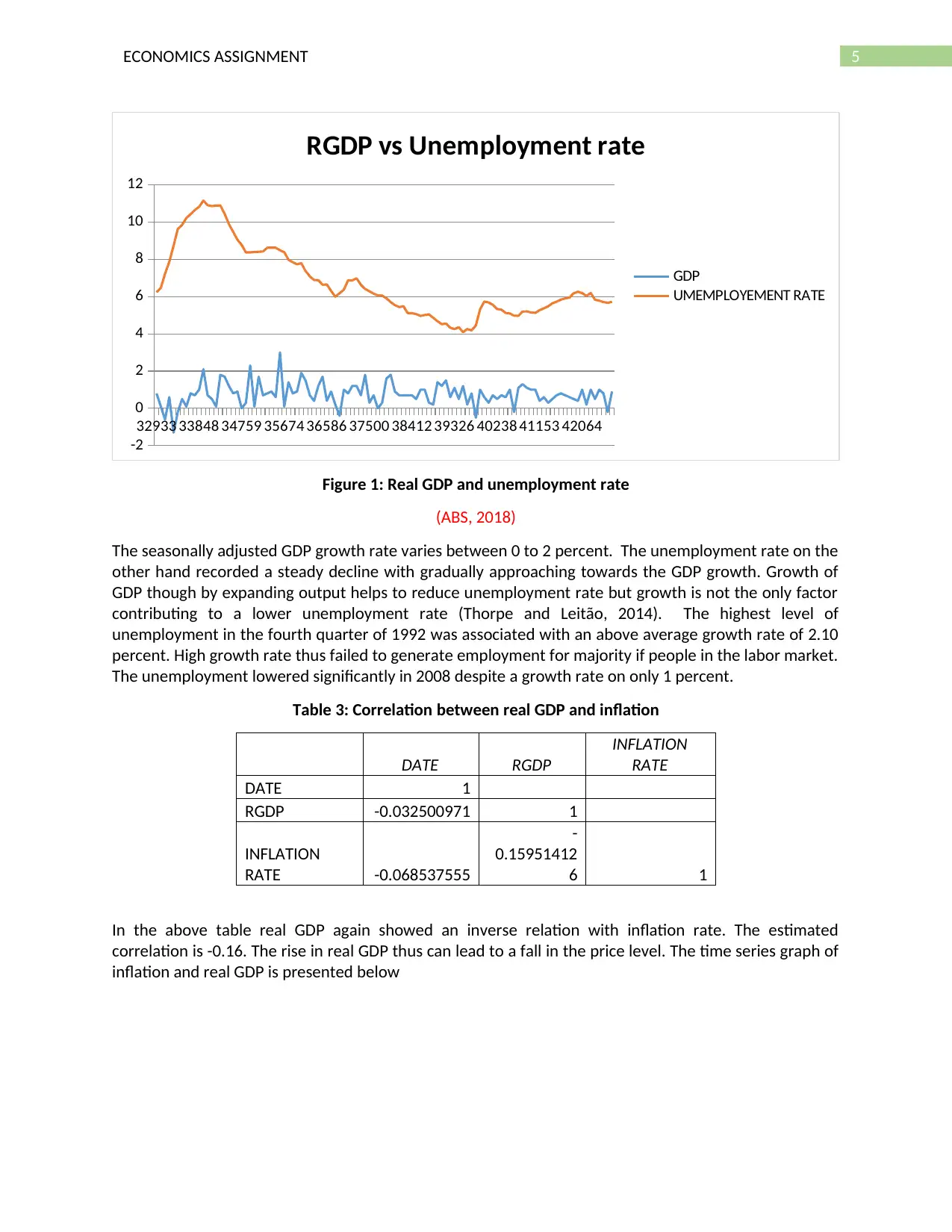
5ECONOMICS ASSIGNMENT
32933 33848 34759 35674 36586 37500 38412 39326 40238 41153 42064
-2
0
2
4
6
8
10
12
RGDP vs Unemployment rate
GDP
UMEMPLOYEMENT RATE
Figure 1: Real GDP and unemployment rate
(ABS, 2018)
The seasonally adjusted GDP growth rate varies between 0 to 2 percent. The unemployment rate on the
other hand recorded a steady decline with gradually approaching towards the GDP growth. Growth of
GDP though by expanding output helps to reduce unemployment rate but growth is not the only factor
contributing to a lower unemployment rate (Thorpe and Leitão, 2014). The highest level of
unemployment in the fourth quarter of 1992 was associated with an above average growth rate of 2.10
percent. High growth rate thus failed to generate employment for majority if people in the labor market.
The unemployment lowered significantly in 2008 despite a growth rate on only 1 percent.
Table 3: Correlation between real GDP and inflation
DATE RGDP
INFLATION
RATE
DATE 1
RGDP -0.032500971 1
INFLATION
RATE -0.068537555
-
0.15951412
6 1
In the above table real GDP again showed an inverse relation with inflation rate. The estimated
correlation is -0.16. The rise in real GDP thus can lead to a fall in the price level. The time series graph of
inflation and real GDP is presented below
32933 33848 34759 35674 36586 37500 38412 39326 40238 41153 42064
-2
0
2
4
6
8
10
12
RGDP vs Unemployment rate
GDP
UMEMPLOYEMENT RATE
Figure 1: Real GDP and unemployment rate
(ABS, 2018)
The seasonally adjusted GDP growth rate varies between 0 to 2 percent. The unemployment rate on the
other hand recorded a steady decline with gradually approaching towards the GDP growth. Growth of
GDP though by expanding output helps to reduce unemployment rate but growth is not the only factor
contributing to a lower unemployment rate (Thorpe and Leitão, 2014). The highest level of
unemployment in the fourth quarter of 1992 was associated with an above average growth rate of 2.10
percent. High growth rate thus failed to generate employment for majority if people in the labor market.
The unemployment lowered significantly in 2008 despite a growth rate on only 1 percent.
Table 3: Correlation between real GDP and inflation
DATE RGDP
INFLATION
RATE
DATE 1
RGDP -0.032500971 1
INFLATION
RATE -0.068537555
-
0.15951412
6 1
In the above table real GDP again showed an inverse relation with inflation rate. The estimated
correlation is -0.16. The rise in real GDP thus can lead to a fall in the price level. The time series graph of
inflation and real GDP is presented below
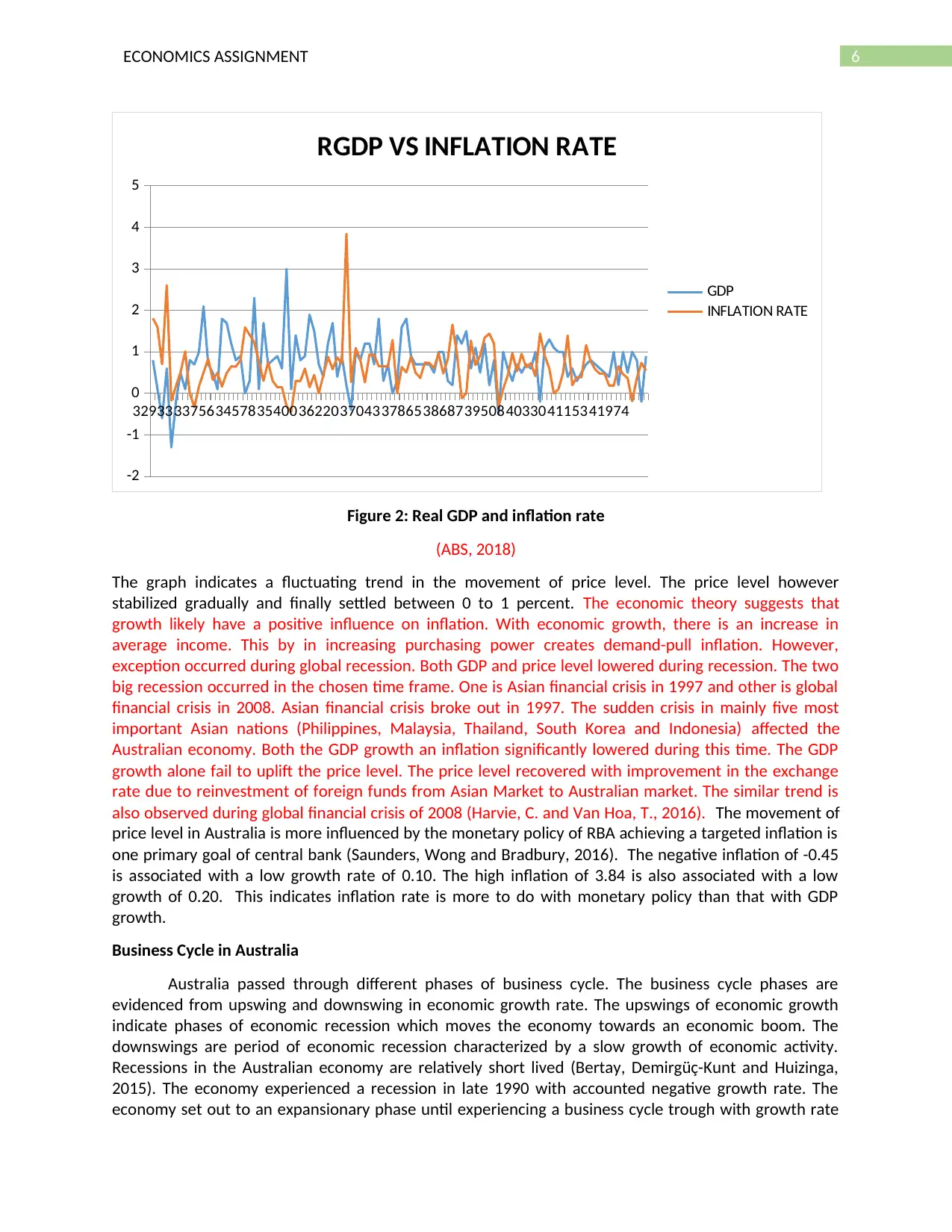
6ECONOMICS ASSIGNMENT
329333375634578354003622037043378653868739508403304115341974
-2
-1
0
1
2
3
4
5
RGDP VS INFLATION RATE
GDP
INFLATION RATE
Figure 2: Real GDP and inflation rate
(ABS, 2018)
The graph indicates a fluctuating trend in the movement of price level. The price level however
stabilized gradually and finally settled between 0 to 1 percent. The economic theory suggests that
growth likely have a positive influence on inflation. With economic growth, there is an increase in
average income. This by in increasing purchasing power creates demand-pull inflation. However,
exception occurred during global recession. Both GDP and price level lowered during recession. The two
big recession occurred in the chosen time frame. One is Asian financial crisis in 1997 and other is global
financial crisis in 2008. Asian financial crisis broke out in 1997. The sudden crisis in mainly five most
important Asian nations (Philippines, Malaysia, Thailand, South Korea and Indonesia) affected the
Australian economy. Both the GDP growth an inflation significantly lowered during this time. The GDP
growth alone fail to uplift the price level. The price level recovered with improvement in the exchange
rate due to reinvestment of foreign funds from Asian Market to Australian market. The similar trend is
also observed during global financial crisis of 2008 (Harvie, C. and Van Hoa, T., 2016). The movement of
price level in Australia is more influenced by the monetary policy of RBA achieving a targeted inflation is
one primary goal of central bank (Saunders, Wong and Bradbury, 2016). The negative inflation of -0.45
is associated with a low growth rate of 0.10. The high inflation of 3.84 is also associated with a low
growth of 0.20. This indicates inflation rate is more to do with monetary policy than that with GDP
growth.
Business Cycle in Australia
Australia passed through different phases of business cycle. The business cycle phases are
evidenced from upswing and downswing in economic growth rate. The upswings of economic growth
indicate phases of economic recession which moves the economy towards an economic boom. The
downswings are period of economic recession characterized by a slow growth of economic activity.
Recessions in the Australian economy are relatively short lived (Bertay, Demirgüç-Kunt and Huizinga,
2015). The economy experienced a recession in late 1990 with accounted negative growth rate. The
economy set out to an expansionary phase until experiencing a business cycle trough with growth rate
329333375634578354003622037043378653868739508403304115341974
-2
-1
0
1
2
3
4
5
RGDP VS INFLATION RATE
GDP
INFLATION RATE
Figure 2: Real GDP and inflation rate
(ABS, 2018)
The graph indicates a fluctuating trend in the movement of price level. The price level however
stabilized gradually and finally settled between 0 to 1 percent. The economic theory suggests that
growth likely have a positive influence on inflation. With economic growth, there is an increase in
average income. This by in increasing purchasing power creates demand-pull inflation. However,
exception occurred during global recession. Both GDP and price level lowered during recession. The two
big recession occurred in the chosen time frame. One is Asian financial crisis in 1997 and other is global
financial crisis in 2008. Asian financial crisis broke out in 1997. The sudden crisis in mainly five most
important Asian nations (Philippines, Malaysia, Thailand, South Korea and Indonesia) affected the
Australian economy. Both the GDP growth an inflation significantly lowered during this time. The GDP
growth alone fail to uplift the price level. The price level recovered with improvement in the exchange
rate due to reinvestment of foreign funds from Asian Market to Australian market. The similar trend is
also observed during global financial crisis of 2008 (Harvie, C. and Van Hoa, T., 2016). The movement of
price level in Australia is more influenced by the monetary policy of RBA achieving a targeted inflation is
one primary goal of central bank (Saunders, Wong and Bradbury, 2016). The negative inflation of -0.45
is associated with a low growth rate of 0.10. The high inflation of 3.84 is also associated with a low
growth of 0.20. This indicates inflation rate is more to do with monetary policy than that with GDP
growth.
Business Cycle in Australia
Australia passed through different phases of business cycle. The business cycle phases are
evidenced from upswing and downswing in economic growth rate. The upswings of economic growth
indicate phases of economic recession which moves the economy towards an economic boom. The
downswings are period of economic recession characterized by a slow growth of economic activity.
Recessions in the Australian economy are relatively short lived (Bertay, Demirgüç-Kunt and Huizinga,
2015). The economy experienced a recession in late 1990 with accounted negative growth rate. The
economy set out to an expansionary phase until experiencing a business cycle trough with growth rate
Paraphrase This Document
Need a fresh take? Get an instant paraphrase of this document with our AI Paraphraser
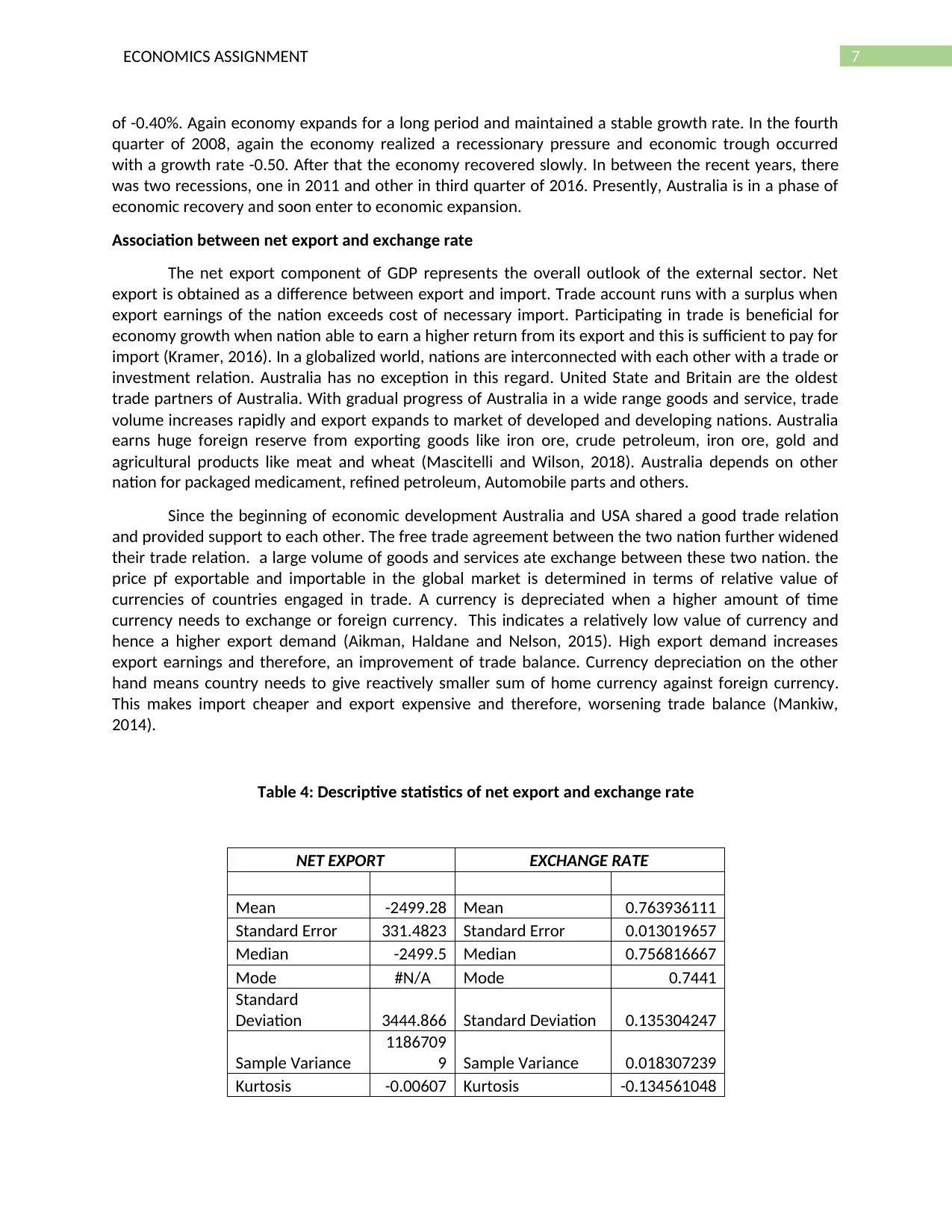
7ECONOMICS ASSIGNMENT
of -0.40%. Again economy expands for a long period and maintained a stable growth rate. In the fourth
quarter of 2008, again the economy realized a recessionary pressure and economic trough occurred
with a growth rate -0.50. After that the economy recovered slowly. In between the recent years, there
was two recessions, one in 2011 and other in third quarter of 2016. Presently, Australia is in a phase of
economic recovery and soon enter to economic expansion.
Association between net export and exchange rate
The net export component of GDP represents the overall outlook of the external sector. Net
export is obtained as a difference between export and import. Trade account runs with a surplus when
export earnings of the nation exceeds cost of necessary import. Participating in trade is beneficial for
economy growth when nation able to earn a higher return from its export and this is sufficient to pay for
import (Kramer, 2016). In a globalized world, nations are interconnected with each other with a trade or
investment relation. Australia has no exception in this regard. United State and Britain are the oldest
trade partners of Australia. With gradual progress of Australia in a wide range goods and service, trade
volume increases rapidly and export expands to market of developed and developing nations. Australia
earns huge foreign reserve from exporting goods like iron ore, crude petroleum, iron ore, gold and
agricultural products like meat and wheat (Mascitelli and Wilson, 2018). Australia depends on other
nation for packaged medicament, refined petroleum, Automobile parts and others.
Since the beginning of economic development Australia and USA shared a good trade relation
and provided support to each other. The free trade agreement between the two nation further widened
their trade relation. a large volume of goods and services ate exchange between these two nation. the
price pf exportable and importable in the global market is determined in terms of relative value of
currencies of countries engaged in trade. A currency is depreciated when a higher amount of time
currency needs to exchange or foreign currency. This indicates a relatively low value of currency and
hence a higher export demand (Aikman, Haldane and Nelson, 2015). High export demand increases
export earnings and therefore, an improvement of trade balance. Currency depreciation on the other
hand means country needs to give reactively smaller sum of home currency against foreign currency.
This makes import cheaper and export expensive and therefore, worsening trade balance (Mankiw,
2014).
Table 4: Descriptive statistics of net export and exchange rate
NET EXPORT EXCHANGE RATE
Mean -2499.28 Mean 0.763936111
Standard Error 331.4823 Standard Error 0.013019657
Median -2499.5 Median 0.756816667
Mode #N/A Mode 0.7441
Standard
Deviation 3444.866 Standard Deviation 0.135304247
Sample Variance
1186709
9 Sample Variance 0.018307239
Kurtosis -0.00607 Kurtosis -0.134561048
of -0.40%. Again economy expands for a long period and maintained a stable growth rate. In the fourth
quarter of 2008, again the economy realized a recessionary pressure and economic trough occurred
with a growth rate -0.50. After that the economy recovered slowly. In between the recent years, there
was two recessions, one in 2011 and other in third quarter of 2016. Presently, Australia is in a phase of
economic recovery and soon enter to economic expansion.
Association between net export and exchange rate
The net export component of GDP represents the overall outlook of the external sector. Net
export is obtained as a difference between export and import. Trade account runs with a surplus when
export earnings of the nation exceeds cost of necessary import. Participating in trade is beneficial for
economy growth when nation able to earn a higher return from its export and this is sufficient to pay for
import (Kramer, 2016). In a globalized world, nations are interconnected with each other with a trade or
investment relation. Australia has no exception in this regard. United State and Britain are the oldest
trade partners of Australia. With gradual progress of Australia in a wide range goods and service, trade
volume increases rapidly and export expands to market of developed and developing nations. Australia
earns huge foreign reserve from exporting goods like iron ore, crude petroleum, iron ore, gold and
agricultural products like meat and wheat (Mascitelli and Wilson, 2018). Australia depends on other
nation for packaged medicament, refined petroleum, Automobile parts and others.
Since the beginning of economic development Australia and USA shared a good trade relation
and provided support to each other. The free trade agreement between the two nation further widened
their trade relation. a large volume of goods and services ate exchange between these two nation. the
price pf exportable and importable in the global market is determined in terms of relative value of
currencies of countries engaged in trade. A currency is depreciated when a higher amount of time
currency needs to exchange or foreign currency. This indicates a relatively low value of currency and
hence a higher export demand (Aikman, Haldane and Nelson, 2015). High export demand increases
export earnings and therefore, an improvement of trade balance. Currency depreciation on the other
hand means country needs to give reactively smaller sum of home currency against foreign currency.
This makes import cheaper and export expensive and therefore, worsening trade balance (Mankiw,
2014).
Table 4: Descriptive statistics of net export and exchange rate
NET EXPORT EXCHANGE RATE
Mean -2499.28 Mean 0.763936111
Standard Error 331.4823 Standard Error 0.013019657
Median -2499.5 Median 0.756816667
Mode #N/A Mode 0.7441
Standard
Deviation 3444.866 Standard Deviation 0.135304247
Sample Variance
1186709
9 Sample Variance 0.018307239
Kurtosis -0.00607 Kurtosis -0.134561048
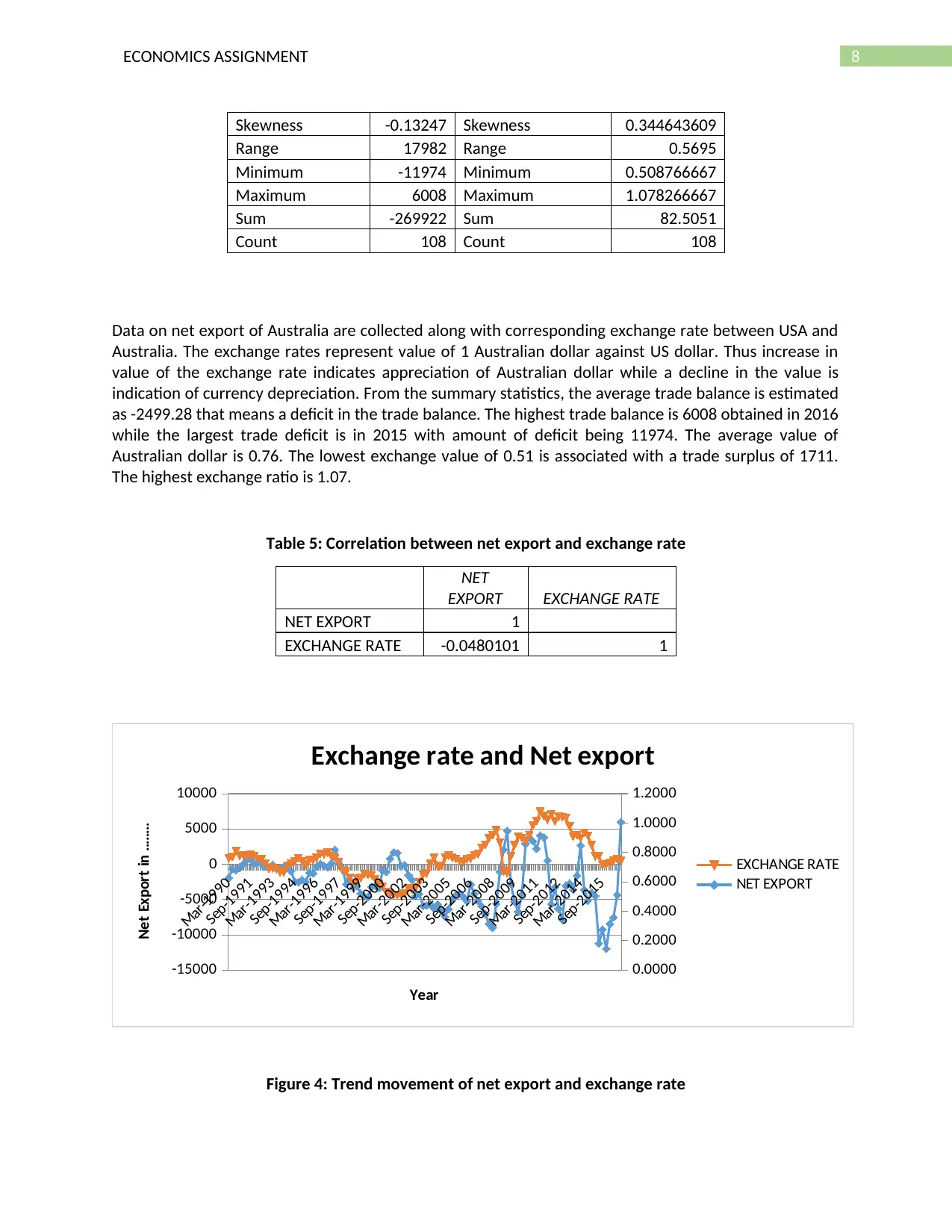
8ECONOMICS ASSIGNMENT
Skewness -0.13247 Skewness 0.344643609
Range 17982 Range 0.5695
Minimum -11974 Minimum 0.508766667
Maximum 6008 Maximum 1.078266667
Sum -269922 Sum 82.5051
Count 108 Count 108
Data on net export of Australia are collected along with corresponding exchange rate between USA and
Australia. The exchange rates represent value of 1 Australian dollar against US dollar. Thus increase in
value of the exchange rate indicates appreciation of Australian dollar while a decline in the value is
indication of currency depreciation. From the summary statistics, the average trade balance is estimated
as -2499.28 that means a deficit in the trade balance. The highest trade balance is 6008 obtained in 2016
while the largest trade deficit is in 2015 with amount of deficit being 11974. The average value of
Australian dollar is 0.76. The lowest exchange value of 0.51 is associated with a trade surplus of 1711.
The highest exchange ratio is 1.07.
Table 5: Correlation between net export and exchange rate
NET
EXPORT EXCHANGE RATE
NET EXPORT 1
EXCHANGE RATE -0.0480101 1
Mar-1990
Sep-1991
Mar-1993
Sep-1994
Mar-1996
Sep-1997
Mar-1999
Sep-2000
Mar-2002
Sep-2003
Mar-2005
Sep-2006
Mar-2008
Sep-2009
Mar-2011
Sep-2012
Mar-2014
Sep-2015
-15000
-10000
-5000
0
5000
10000
0.0000
0.2000
0.4000
0.6000
0.8000
1.0000
1.2000
Exchange rate and Net export
EXCHANGE RATE
NET EXPORT
Year
Net Export in ........
Figure 4: Trend movement of net export and exchange rate
Skewness -0.13247 Skewness 0.344643609
Range 17982 Range 0.5695
Minimum -11974 Minimum 0.508766667
Maximum 6008 Maximum 1.078266667
Sum -269922 Sum 82.5051
Count 108 Count 108
Data on net export of Australia are collected along with corresponding exchange rate between USA and
Australia. The exchange rates represent value of 1 Australian dollar against US dollar. Thus increase in
value of the exchange rate indicates appreciation of Australian dollar while a decline in the value is
indication of currency depreciation. From the summary statistics, the average trade balance is estimated
as -2499.28 that means a deficit in the trade balance. The highest trade balance is 6008 obtained in 2016
while the largest trade deficit is in 2015 with amount of deficit being 11974. The average value of
Australian dollar is 0.76. The lowest exchange value of 0.51 is associated with a trade surplus of 1711.
The highest exchange ratio is 1.07.
Table 5: Correlation between net export and exchange rate
NET
EXPORT EXCHANGE RATE
NET EXPORT 1
EXCHANGE RATE -0.0480101 1
Mar-1990
Sep-1991
Mar-1993
Sep-1994
Mar-1996
Sep-1997
Mar-1999
Sep-2000
Mar-2002
Sep-2003
Mar-2005
Sep-2006
Mar-2008
Sep-2009
Mar-2011
Sep-2012
Mar-2014
Sep-2015
-15000
-10000
-5000
0
5000
10000
0.0000
0.2000
0.4000
0.6000
0.8000
1.0000
1.2000
Exchange rate and Net export
EXCHANGE RATE
NET EXPORT
Year
Net Export in ........
Figure 4: Trend movement of net export and exchange rate
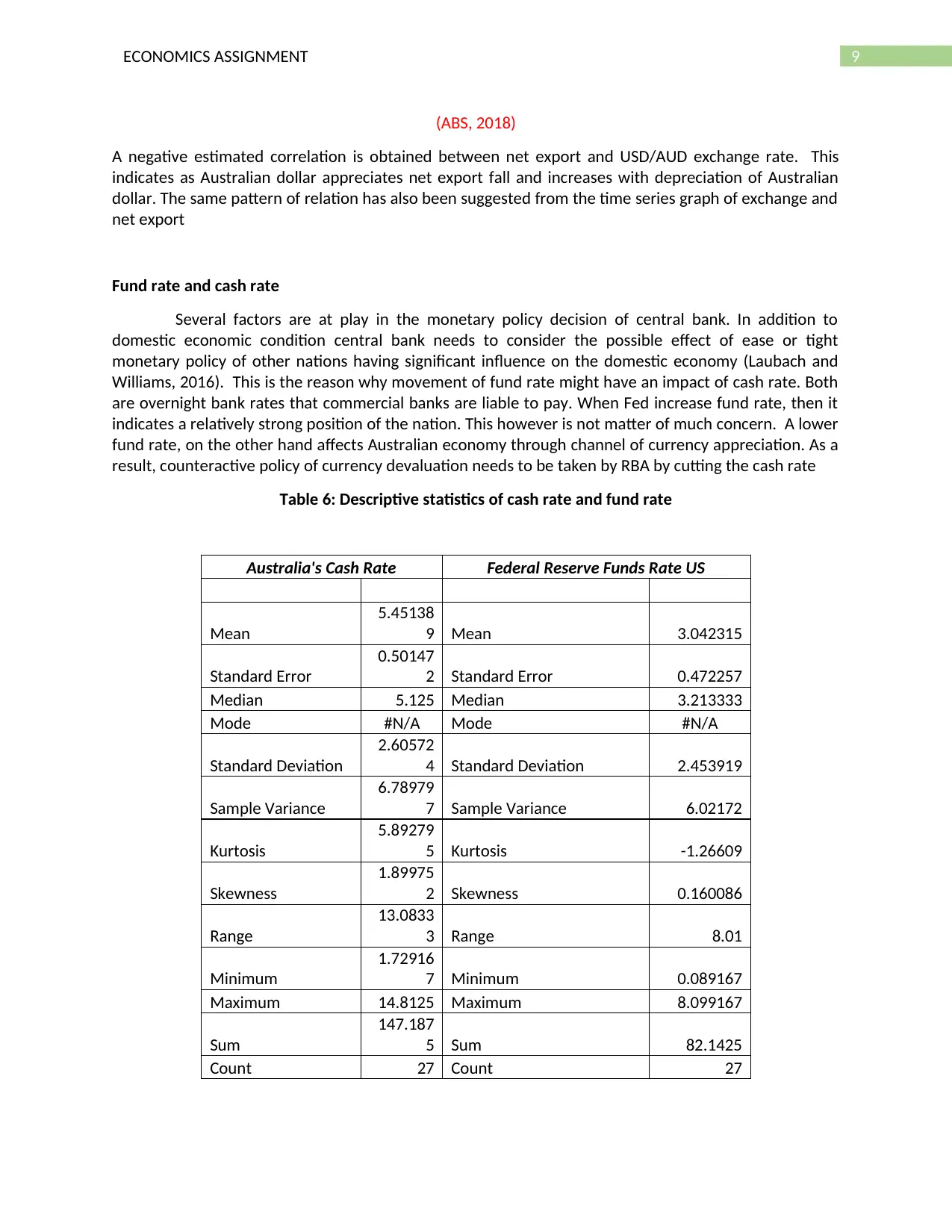
9ECONOMICS ASSIGNMENT
(ABS, 2018)
A negative estimated correlation is obtained between net export and USD/AUD exchange rate. This
indicates as Australian dollar appreciates net export fall and increases with depreciation of Australian
dollar. The same pattern of relation has also been suggested from the time series graph of exchange and
net export
Fund rate and cash rate
Several factors are at play in the monetary policy decision of central bank. In addition to
domestic economic condition central bank needs to consider the possible effect of ease or tight
monetary policy of other nations having significant influence on the domestic economy (Laubach and
Williams, 2016). This is the reason why movement of fund rate might have an impact of cash rate. Both
are overnight bank rates that commercial banks are liable to pay. When Fed increase fund rate, then it
indicates a relatively strong position of the nation. This however is not matter of much concern. A lower
fund rate, on the other hand affects Australian economy through channel of currency appreciation. As a
result, counteractive policy of currency devaluation needs to be taken by RBA by cutting the cash rate
Table 6: Descriptive statistics of cash rate and fund rate
Australia's Cash Rate Federal Reserve Funds Rate US
Mean
5.45138
9 Mean 3.042315
Standard Error
0.50147
2 Standard Error 0.472257
Median 5.125 Median 3.213333
Mode #N/A Mode #N/A
Standard Deviation
2.60572
4 Standard Deviation 2.453919
Sample Variance
6.78979
7 Sample Variance 6.02172
Kurtosis
5.89279
5 Kurtosis -1.26609
Skewness
1.89975
2 Skewness 0.160086
Range
13.0833
3 Range 8.01
Minimum
1.72916
7 Minimum 0.089167
Maximum 14.8125 Maximum 8.099167
Sum
147.187
5 Sum 82.1425
Count 27 Count 27
(ABS, 2018)
A negative estimated correlation is obtained between net export and USD/AUD exchange rate. This
indicates as Australian dollar appreciates net export fall and increases with depreciation of Australian
dollar. The same pattern of relation has also been suggested from the time series graph of exchange and
net export
Fund rate and cash rate
Several factors are at play in the monetary policy decision of central bank. In addition to
domestic economic condition central bank needs to consider the possible effect of ease or tight
monetary policy of other nations having significant influence on the domestic economy (Laubach and
Williams, 2016). This is the reason why movement of fund rate might have an impact of cash rate. Both
are overnight bank rates that commercial banks are liable to pay. When Fed increase fund rate, then it
indicates a relatively strong position of the nation. This however is not matter of much concern. A lower
fund rate, on the other hand affects Australian economy through channel of currency appreciation. As a
result, counteractive policy of currency devaluation needs to be taken by RBA by cutting the cash rate
Table 6: Descriptive statistics of cash rate and fund rate
Australia's Cash Rate Federal Reserve Funds Rate US
Mean
5.45138
9 Mean 3.042315
Standard Error
0.50147
2 Standard Error 0.472257
Median 5.125 Median 3.213333
Mode #N/A Mode #N/A
Standard Deviation
2.60572
4 Standard Deviation 2.453919
Sample Variance
6.78979
7 Sample Variance 6.02172
Kurtosis
5.89279
5 Kurtosis -1.26609
Skewness
1.89975
2 Skewness 0.160086
Range
13.0833
3 Range 8.01
Minimum
1.72916
7 Minimum 0.089167
Maximum 14.8125 Maximum 8.099167
Sum
147.187
5 Sum 82.1425
Count 27 Count 27
Secure Best Marks with AI Grader
Need help grading? Try our AI Grader for instant feedback on your assignments.

10ECONOMICS ASSIGNMENT
Table 7: Correlation between cash rate and fund rate
Australia's Cash Rate Federal Reserve Funds Rate US
Australia's Cash Rate 1
Federal Reserve Funds Rate
US 0.762159991 1
A very high correlation is found to exists between cash rate and fund rate. The correlation
between the two rate is 0.76. This indicates strong association between the two nations in terms of
monetary policy.
1990
1992
1994
1996
1998
2000
2002
2004
2006
2008
2010
2012
2014
2016
0
2
4
6
8
10
12
14
16
Relationship between Australia's Cash Rate and Federal
Reserve Funds Rate
Australia's Cash Rate
Federal Reserve Funds Rate US
Year
Cash rate of Australia and USA
Figure 5: Relation between cash rate and fund rate
(FRED, 2018)
The result from correlation has further strengthened by similar trend of cash rate and fund rates over
time. Starting from a very high rate, a gradual decline has been observed for both cash rate and fund
rate. The cash rate however remained higher than fund rate throughout the entire period. The gap
between cash rate and fund rate found to be increased significantly particularly after Global Financial
crisis (Cummings and Wright, 2016). This us because USA economy that time needed greater monetary
stimulus than Australia did. Though s high correlation is obtained between cash rate and fund rate
however in practical RBA’s decision of cash rate does not much depends on fund rate. It is state of
domestic economy that influences cash rate. Fed had lowered the fund rate especially after global
financial crisis to expand lending opportunities and stimulates economic growth in USA. This kind of
policy reflect expansionary monetary policy. After the crisis over Fed started to raise fund rate from
2015 (Rey, H., 2015). RBA alters cash to control the inflation rate. This is not always influenced by fund
rate. In recent years, a hike in fund rate RBA had not change the cash rate and its remained at 1.50
percent (RBA, 2018).
Forecasting economic outlook
Table 7: Correlation between cash rate and fund rate
Australia's Cash Rate Federal Reserve Funds Rate US
Australia's Cash Rate 1
Federal Reserve Funds Rate
US 0.762159991 1
A very high correlation is found to exists between cash rate and fund rate. The correlation
between the two rate is 0.76. This indicates strong association between the two nations in terms of
monetary policy.
1990
1992
1994
1996
1998
2000
2002
2004
2006
2008
2010
2012
2014
2016
0
2
4
6
8
10
12
14
16
Relationship between Australia's Cash Rate and Federal
Reserve Funds Rate
Australia's Cash Rate
Federal Reserve Funds Rate US
Year
Cash rate of Australia and USA
Figure 5: Relation between cash rate and fund rate
(FRED, 2018)
The result from correlation has further strengthened by similar trend of cash rate and fund rates over
time. Starting from a very high rate, a gradual decline has been observed for both cash rate and fund
rate. The cash rate however remained higher than fund rate throughout the entire period. The gap
between cash rate and fund rate found to be increased significantly particularly after Global Financial
crisis (Cummings and Wright, 2016). This us because USA economy that time needed greater monetary
stimulus than Australia did. Though s high correlation is obtained between cash rate and fund rate
however in practical RBA’s decision of cash rate does not much depends on fund rate. It is state of
domestic economy that influences cash rate. Fed had lowered the fund rate especially after global
financial crisis to expand lending opportunities and stimulates economic growth in USA. This kind of
policy reflect expansionary monetary policy. After the crisis over Fed started to raise fund rate from
2015 (Rey, H., 2015). RBA alters cash to control the inflation rate. This is not always influenced by fund
rate. In recent years, a hike in fund rate RBA had not change the cash rate and its remained at 1.50
percent (RBA, 2018).
Forecasting economic outlook
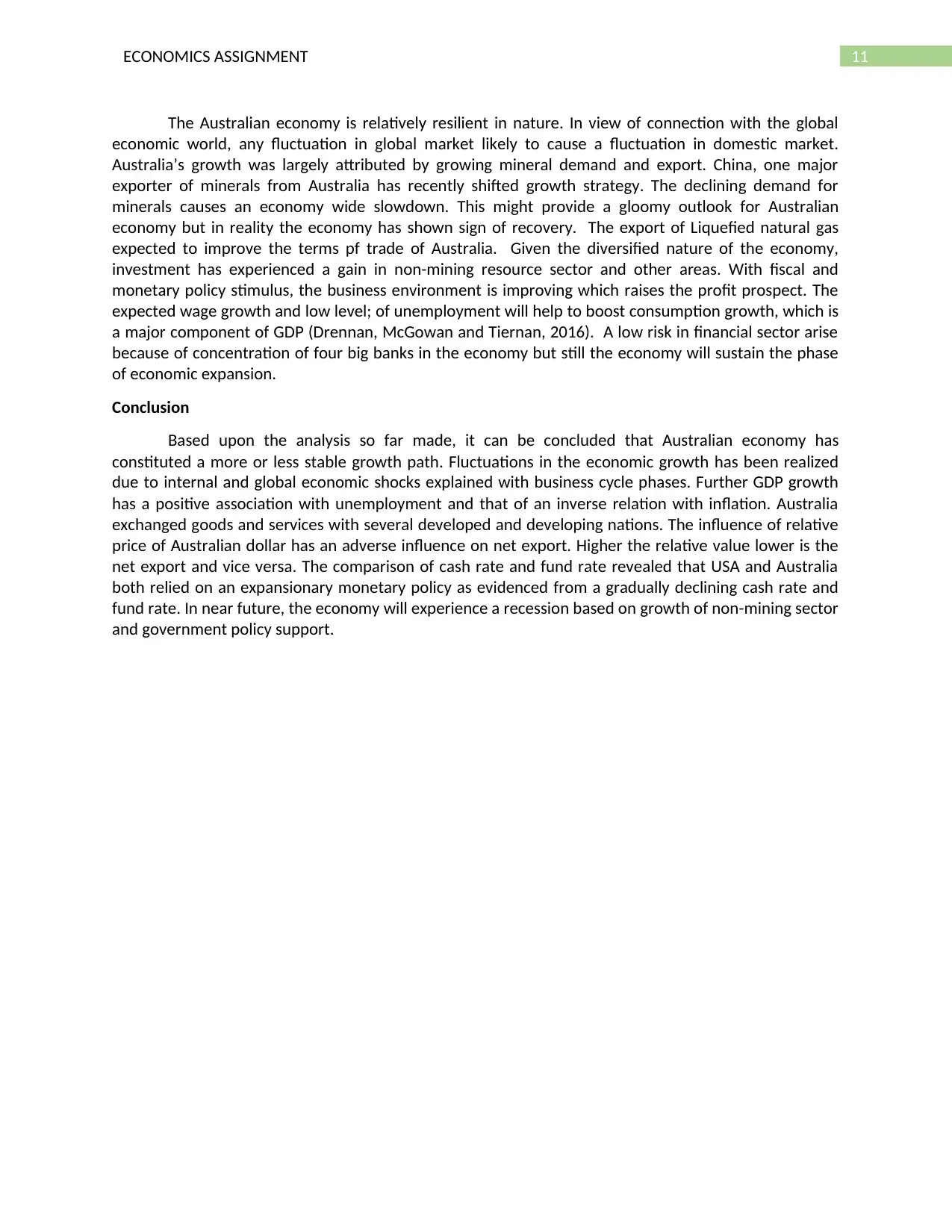
11ECONOMICS ASSIGNMENT
The Australian economy is relatively resilient in nature. In view of connection with the global
economic world, any fluctuation in global market likely to cause a fluctuation in domestic market.
Australia’s growth was largely attributed by growing mineral demand and export. China, one major
exporter of minerals from Australia has recently shifted growth strategy. The declining demand for
minerals causes an economy wide slowdown. This might provide a gloomy outlook for Australian
economy but in reality the economy has shown sign of recovery. The export of Liquefied natural gas
expected to improve the terms pf trade of Australia. Given the diversified nature of the economy,
investment has experienced a gain in non-mining resource sector and other areas. With fiscal and
monetary policy stimulus, the business environment is improving which raises the profit prospect. The
expected wage growth and low level; of unemployment will help to boost consumption growth, which is
a major component of GDP (Drennan, McGowan and Tiernan, 2016). A low risk in financial sector arise
because of concentration of four big banks in the economy but still the economy will sustain the phase
of economic expansion.
Conclusion
Based upon the analysis so far made, it can be concluded that Australian economy has
constituted a more or less stable growth path. Fluctuations in the economic growth has been realized
due to internal and global economic shocks explained with business cycle phases. Further GDP growth
has a positive association with unemployment and that of an inverse relation with inflation. Australia
exchanged goods and services with several developed and developing nations. The influence of relative
price of Australian dollar has an adverse influence on net export. Higher the relative value lower is the
net export and vice versa. The comparison of cash rate and fund rate revealed that USA and Australia
both relied on an expansionary monetary policy as evidenced from a gradually declining cash rate and
fund rate. In near future, the economy will experience a recession based on growth of non-mining sector
and government policy support.
The Australian economy is relatively resilient in nature. In view of connection with the global
economic world, any fluctuation in global market likely to cause a fluctuation in domestic market.
Australia’s growth was largely attributed by growing mineral demand and export. China, one major
exporter of minerals from Australia has recently shifted growth strategy. The declining demand for
minerals causes an economy wide slowdown. This might provide a gloomy outlook for Australian
economy but in reality the economy has shown sign of recovery. The export of Liquefied natural gas
expected to improve the terms pf trade of Australia. Given the diversified nature of the economy,
investment has experienced a gain in non-mining resource sector and other areas. With fiscal and
monetary policy stimulus, the business environment is improving which raises the profit prospect. The
expected wage growth and low level; of unemployment will help to boost consumption growth, which is
a major component of GDP (Drennan, McGowan and Tiernan, 2016). A low risk in financial sector arise
because of concentration of four big banks in the economy but still the economy will sustain the phase
of economic expansion.
Conclusion
Based upon the analysis so far made, it can be concluded that Australian economy has
constituted a more or less stable growth path. Fluctuations in the economic growth has been realized
due to internal and global economic shocks explained with business cycle phases. Further GDP growth
has a positive association with unemployment and that of an inverse relation with inflation. Australia
exchanged goods and services with several developed and developing nations. The influence of relative
price of Australian dollar has an adverse influence on net export. Higher the relative value lower is the
net export and vice versa. The comparison of cash rate and fund rate revealed that USA and Australia
both relied on an expansionary monetary policy as evidenced from a gradually declining cash rate and
fund rate. In near future, the economy will experience a recession based on growth of non-mining sector
and government policy support.
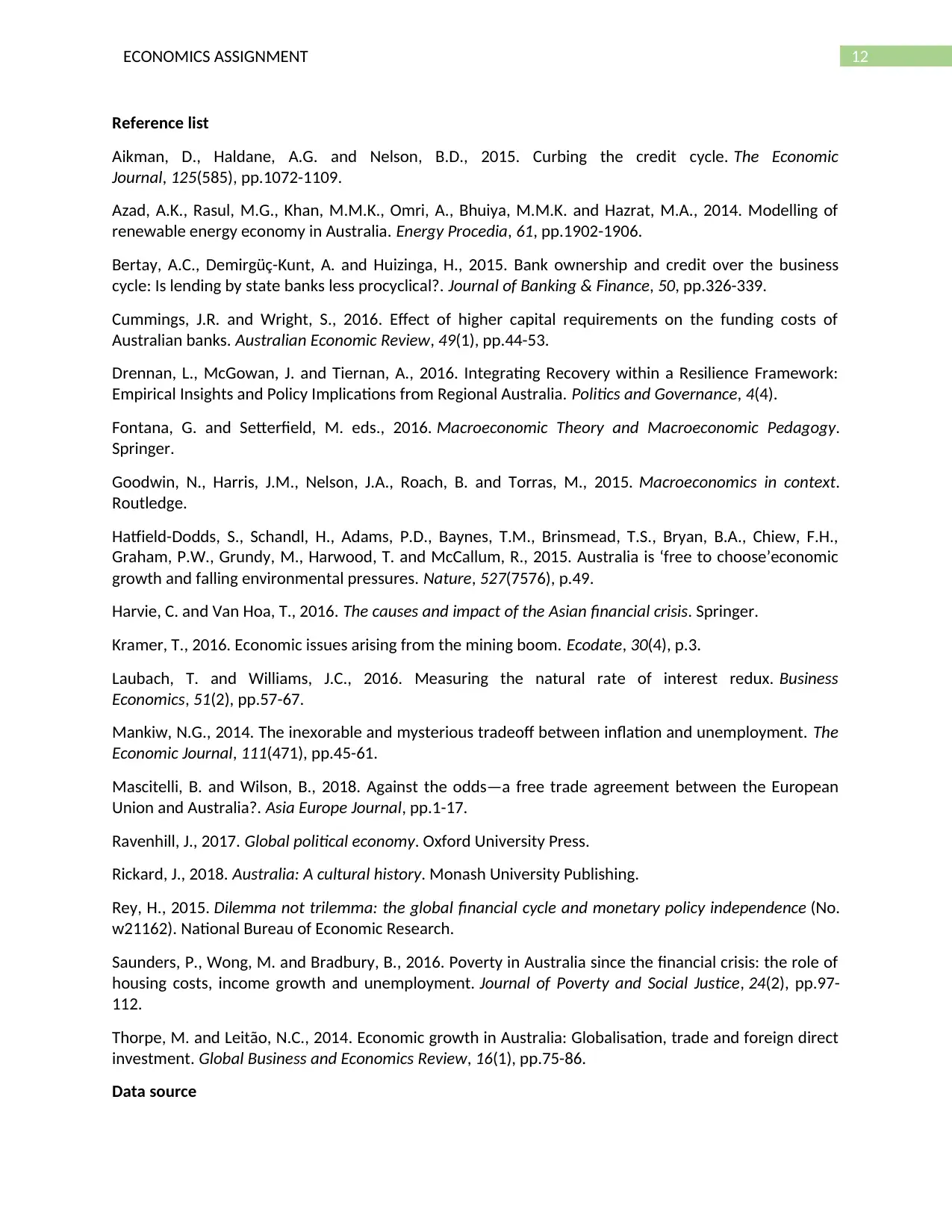
12ECONOMICS ASSIGNMENT
Reference list
Aikman, D., Haldane, A.G. and Nelson, B.D., 2015. Curbing the credit cycle. The Economic
Journal, 125(585), pp.1072-1109.
Azad, A.K., Rasul, M.G., Khan, M.M.K., Omri, A., Bhuiya, M.M.K. and Hazrat, M.A., 2014. Modelling of
renewable energy economy in Australia. Energy Procedia, 61, pp.1902-1906.
Bertay, A.C., Demirgüç-Kunt, A. and Huizinga, H., 2015. Bank ownership and credit over the business
cycle: Is lending by state banks less procyclical?. Journal of Banking & Finance, 50, pp.326-339.
Cummings, J.R. and Wright, S., 2016. Effect of higher capital requirements on the funding costs of
Australian banks. Australian Economic Review, 49(1), pp.44-53.
Drennan, L., McGowan, J. and Tiernan, A., 2016. Integrating Recovery within a Resilience Framework:
Empirical Insights and Policy Implications from Regional Australia. Politics and Governance, 4(4).
Fontana, G. and Setterfield, M. eds., 2016. Macroeconomic Theory and Macroeconomic Pedagogy.
Springer.
Goodwin, N., Harris, J.M., Nelson, J.A., Roach, B. and Torras, M., 2015. Macroeconomics in context.
Routledge.
Hatfield-Dodds, S., Schandl, H., Adams, P.D., Baynes, T.M., Brinsmead, T.S., Bryan, B.A., Chiew, F.H.,
Graham, P.W., Grundy, M., Harwood, T. and McCallum, R., 2015. Australia is ‘free to choose’economic
growth and falling environmental pressures. Nature, 527(7576), p.49.
Harvie, C. and Van Hoa, T., 2016. The causes and impact of the Asian financial crisis. Springer.
Kramer, T., 2016. Economic issues arising from the mining boom. Ecodate, 30(4), p.3.
Laubach, T. and Williams, J.C., 2016. Measuring the natural rate of interest redux. Business
Economics, 51(2), pp.57-67.
Mankiw, N.G., 2014. The inexorable and mysterious tradeoff between inflation and unemployment. The
Economic Journal, 111(471), pp.45-61.
Mascitelli, B. and Wilson, B., 2018. Against the odds—a free trade agreement between the European
Union and Australia?. Asia Europe Journal, pp.1-17.
Ravenhill, J., 2017. Global political economy. Oxford University Press.
Rickard, J., 2018. Australia: A cultural history. Monash University Publishing.
Rey, H., 2015. Dilemma not trilemma: the global financial cycle and monetary policy independence (No.
w21162). National Bureau of Economic Research.
Saunders, P., Wong, M. and Bradbury, B., 2016. Poverty in Australia since the financial crisis: the role of
housing costs, income growth and unemployment. Journal of Poverty and Social Justice, 24(2), pp.97-
112.
Thorpe, M. and Leitão, N.C., 2014. Economic growth in Australia: Globalisation, trade and foreign direct
investment. Global Business and Economics Review, 16(1), pp.75-86.
Data source
Reference list
Aikman, D., Haldane, A.G. and Nelson, B.D., 2015. Curbing the credit cycle. The Economic
Journal, 125(585), pp.1072-1109.
Azad, A.K., Rasul, M.G., Khan, M.M.K., Omri, A., Bhuiya, M.M.K. and Hazrat, M.A., 2014. Modelling of
renewable energy economy in Australia. Energy Procedia, 61, pp.1902-1906.
Bertay, A.C., Demirgüç-Kunt, A. and Huizinga, H., 2015. Bank ownership and credit over the business
cycle: Is lending by state banks less procyclical?. Journal of Banking & Finance, 50, pp.326-339.
Cummings, J.R. and Wright, S., 2016. Effect of higher capital requirements on the funding costs of
Australian banks. Australian Economic Review, 49(1), pp.44-53.
Drennan, L., McGowan, J. and Tiernan, A., 2016. Integrating Recovery within a Resilience Framework:
Empirical Insights and Policy Implications from Regional Australia. Politics and Governance, 4(4).
Fontana, G. and Setterfield, M. eds., 2016. Macroeconomic Theory and Macroeconomic Pedagogy.
Springer.
Goodwin, N., Harris, J.M., Nelson, J.A., Roach, B. and Torras, M., 2015. Macroeconomics in context.
Routledge.
Hatfield-Dodds, S., Schandl, H., Adams, P.D., Baynes, T.M., Brinsmead, T.S., Bryan, B.A., Chiew, F.H.,
Graham, P.W., Grundy, M., Harwood, T. and McCallum, R., 2015. Australia is ‘free to choose’economic
growth and falling environmental pressures. Nature, 527(7576), p.49.
Harvie, C. and Van Hoa, T., 2016. The causes and impact of the Asian financial crisis. Springer.
Kramer, T., 2016. Economic issues arising from the mining boom. Ecodate, 30(4), p.3.
Laubach, T. and Williams, J.C., 2016. Measuring the natural rate of interest redux. Business
Economics, 51(2), pp.57-67.
Mankiw, N.G., 2014. The inexorable and mysterious tradeoff between inflation and unemployment. The
Economic Journal, 111(471), pp.45-61.
Mascitelli, B. and Wilson, B., 2018. Against the odds—a free trade agreement between the European
Union and Australia?. Asia Europe Journal, pp.1-17.
Ravenhill, J., 2017. Global political economy. Oxford University Press.
Rickard, J., 2018. Australia: A cultural history. Monash University Publishing.
Rey, H., 2015. Dilemma not trilemma: the global financial cycle and monetary policy independence (No.
w21162). National Bureau of Economic Research.
Saunders, P., Wong, M. and Bradbury, B., 2016. Poverty in Australia since the financial crisis: the role of
housing costs, income growth and unemployment. Journal of Poverty and Social Justice, 24(2), pp.97-
112.
Thorpe, M. and Leitão, N.C., 2014. Economic growth in Australia: Globalisation, trade and foreign direct
investment. Global Business and Economics Review, 16(1), pp.75-86.
Data source
Paraphrase This Document
Need a fresh take? Get an instant paraphrase of this document with our AI Paraphraser
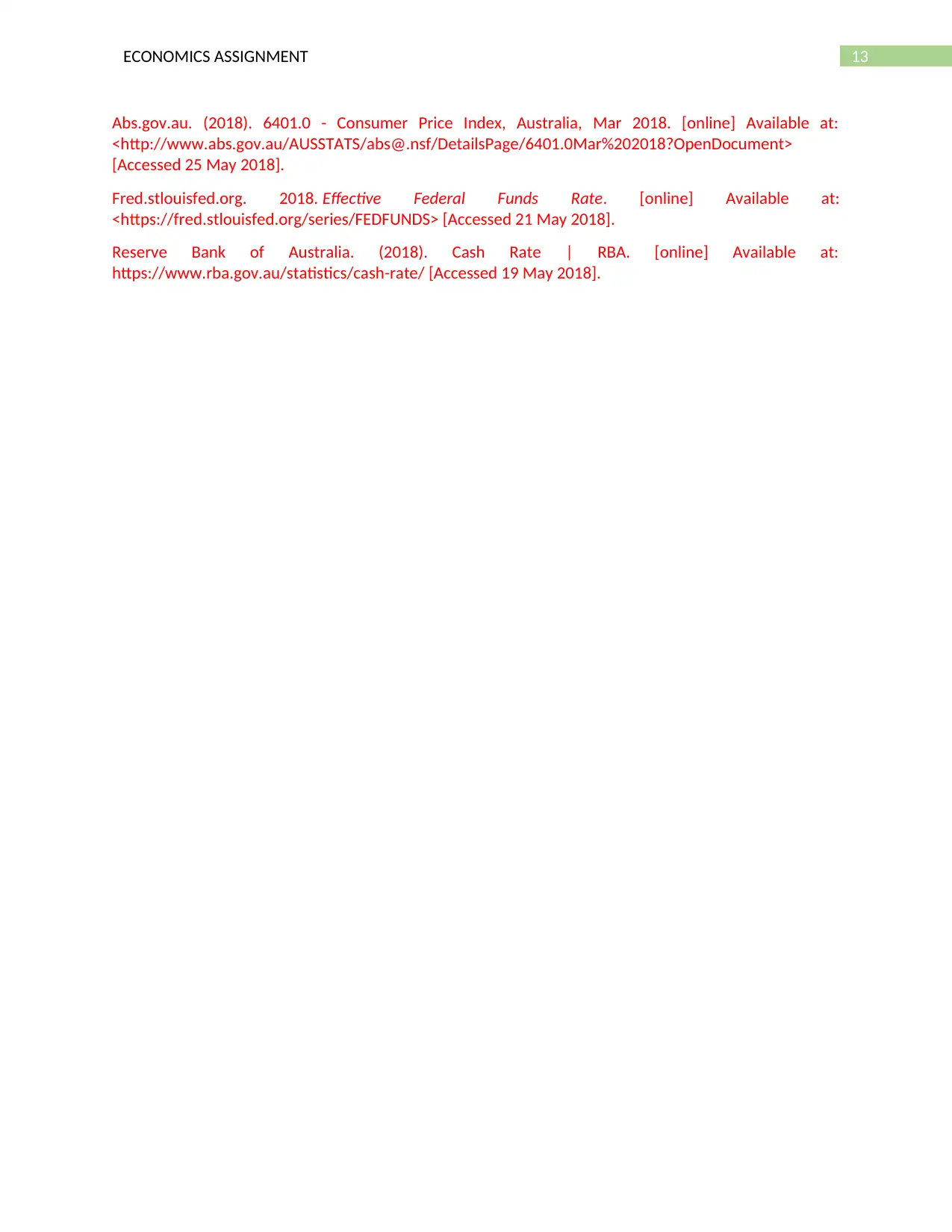
13ECONOMICS ASSIGNMENT
Abs.gov.au. (2018). 6401.0 - Consumer Price Index, Australia, Mar 2018. [online] Available at:
<http://www.abs.gov.au/AUSSTATS/abs@.nsf/DetailsPage/6401.0Mar%202018?OpenDocument>
[Accessed 25 May 2018].
Fred.stlouisfed.org. 2018. Effective Federal Funds Rate. [online] Available at:
<https://fred.stlouisfed.org/series/FEDFUNDS> [Accessed 21 May 2018].
Reserve Bank of Australia. (2018). Cash Rate | RBA. [online] Available at:
https://www.rba.gov.au/statistics/cash-rate/ [Accessed 19 May 2018].
Abs.gov.au. (2018). 6401.0 - Consumer Price Index, Australia, Mar 2018. [online] Available at:
<http://www.abs.gov.au/AUSSTATS/abs@.nsf/DetailsPage/6401.0Mar%202018?OpenDocument>
[Accessed 25 May 2018].
Fred.stlouisfed.org. 2018. Effective Federal Funds Rate. [online] Available at:
<https://fred.stlouisfed.org/series/FEDFUNDS> [Accessed 21 May 2018].
Reserve Bank of Australia. (2018). Cash Rate | RBA. [online] Available at:
https://www.rba.gov.au/statistics/cash-rate/ [Accessed 19 May 2018].
1 out of 14
Related Documents
Your All-in-One AI-Powered Toolkit for Academic Success.
+13062052269
info@desklib.com
Available 24*7 on WhatsApp / Email
![[object Object]](/_next/static/media/star-bottom.7253800d.svg)
Unlock your academic potential
© 2024 | Zucol Services PVT LTD | All rights reserved.





